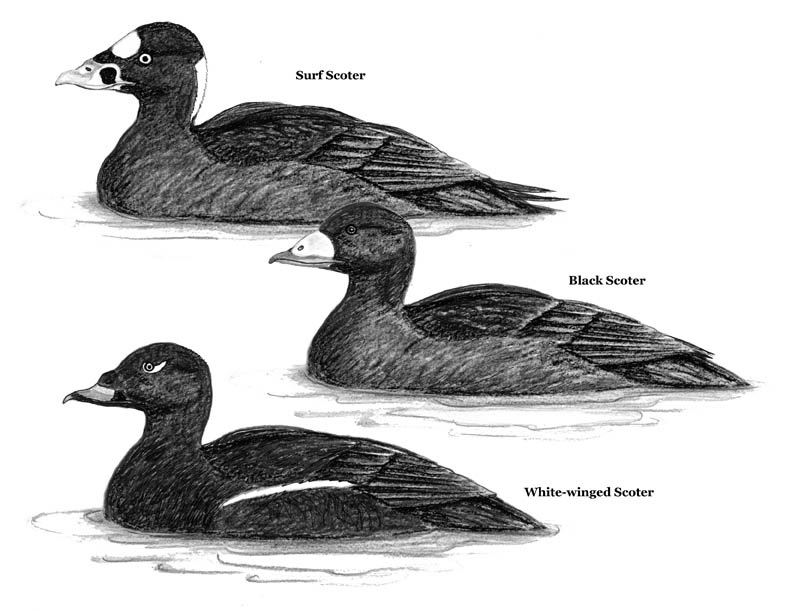
Dear Bird Folks,
My husband and I, and our new binoculars, have been walking the beach a lot this winter. One group of birds that has caught our attention is the scoters. My book says that we get three different species of scoters on the Cape, but I’m not sure if I can tell the difference. Any advice?
– Marion, Wellfleet, MA
Good for you, Marion,
I’m glad you have your binoculars with you when you walk the beach. I’m shocked by how many people I see on the beach who have forgotten to carry binos with them. (They never forget to take their stinky dogs, though.) What are these people thinking? They are missing great birds. Folks are constantly asking me how they can get “different” birds to come to their yards. Apparently, finches, cardinals and chickadees just don’t do it for them anymore. They want a new feeder and some new food that will bring them new birds. (Of course, I happily sell them all new stuff. Who am I to stand in the way of their dreams?) But the truth is, there is only a limited number of birds that will come to feeders. If people want to see new birds, all they need to do is go to the beach and look offshore. This time of year the ocean is filled with a whole host of birds, including loons, eiders, grebes, mergansers, gannets and scoters. Instead of buying a new bird feeder, people just need to remember their binoculars the next time they walk the beach. And if they need binoculars, I can help them with that, too.
Before I get into discussing scoters, I should mention that “scoter” is one of those bird names that give many folks pronunciation issues. For some reason, newbies want to say “scooter,” like they are talking about a kid’s toy or a Scooter Pie (remember those?). The “o” in scoter is the long “O” sound, just like in the name Nova Scotia or, if you have friends in Florida, Boca. The other bird names people have trouble with are Sharp-shinned Hawk (it’s not sharp-skinned), Great Blue Heron (not great blue herring) and any warbler (eastern Massachusetts people only).
Scoters are hardy sea ducks that breed in the far north and spend the winter along the coast. There are five species of scoters in the world, with three of them found in the waters of Cape Cod. Black Scoters, White-winged Scoters and Surf Scoters can be seen here anytime of year, but they are particularly abundant during the colder months. In addition to the three mentioned, there are two other scoter species that are found in Europe. European scoters have the boringly named Common Scoter and the weirdly titled Velvet Scoter, which sounds like it should be in a painting hanging in Huge Hefner’s bedroom.
Like eiders, scoters feed on mussels and other such clammy things. They gather food by diving below the icy waters and plucking the mollusks off the ocean floor. Obviously, there is a limit to how deep the ducks can dive (usually about thirty feet). As result, scoters are regularly found close to shore, where we can see them. Just don’t expect to see a scoter rise to the surface with a mouthful of clams. More often than not, the birds swallow the shellfish before they reach the surface. Their powerful gizzards then take it from there. They can digest mussels or clams, shells and all, without so much as a burp. Meanwhile, we humans need a daily dose of Tums or Zantac just to eat tacos or Scooter Pies.
Identifying our three scoters is fairly easy. (Note: Right now I’ll only be discussing adult male scoters. The duller females and young birds are more challenging and will have to wait for another day.) Figuring out male scoters is certainly much easier than sorting out generic shorebirds or identifying which chocolate in the box has the caramel filling and which has the nasty fruit jelly inside. As you might expect, Black Scoters are black, really black. Like a crow, the adult male Black Scoter is totally covered in black feathers. However, it does have one non-black feature on its bill: The base of the bill has a bright orange-yellow blotch on it, which makes the bird look like it just stuck its face in bag of Cheetos.
The White-winged Scoter is also mostly black, but it does have two helpful field marks. One is a definitive white mark under each eye, which makes the bird look like it has a white black eye (if there can be such a thing). The white wing of the White-winged Scoter is sometimes obvious, while other times it is subtler. But there is nothing subtle about the white when the bird opens its wings or when it’s flying. At this point, the white is flashy and very conspicuous, like a person on the beach in the winter without binoculars.
I think the last scoter, the Surf Scoter, is the most handsome of the three. Once again, it is all black, but the forehead and the back of the neck have large white patches on them. But the standout feature on this bird is the beak. The beak is huge, part black, part white and part bright orange. The bird looks like it just finished a plate of mussels and is now having a Creamsicle for dessert. I’m not sure if the field guides use the Creamsicle analogy, but they should.
I’m glad you and your husband are enjoying the birds on the Cape’s beaches this winter, Marion. I love this time of year. Although with Patti gone, walking the beaches of Old Cape Cod just won’t be the same anymore. RIP, Miss Page.